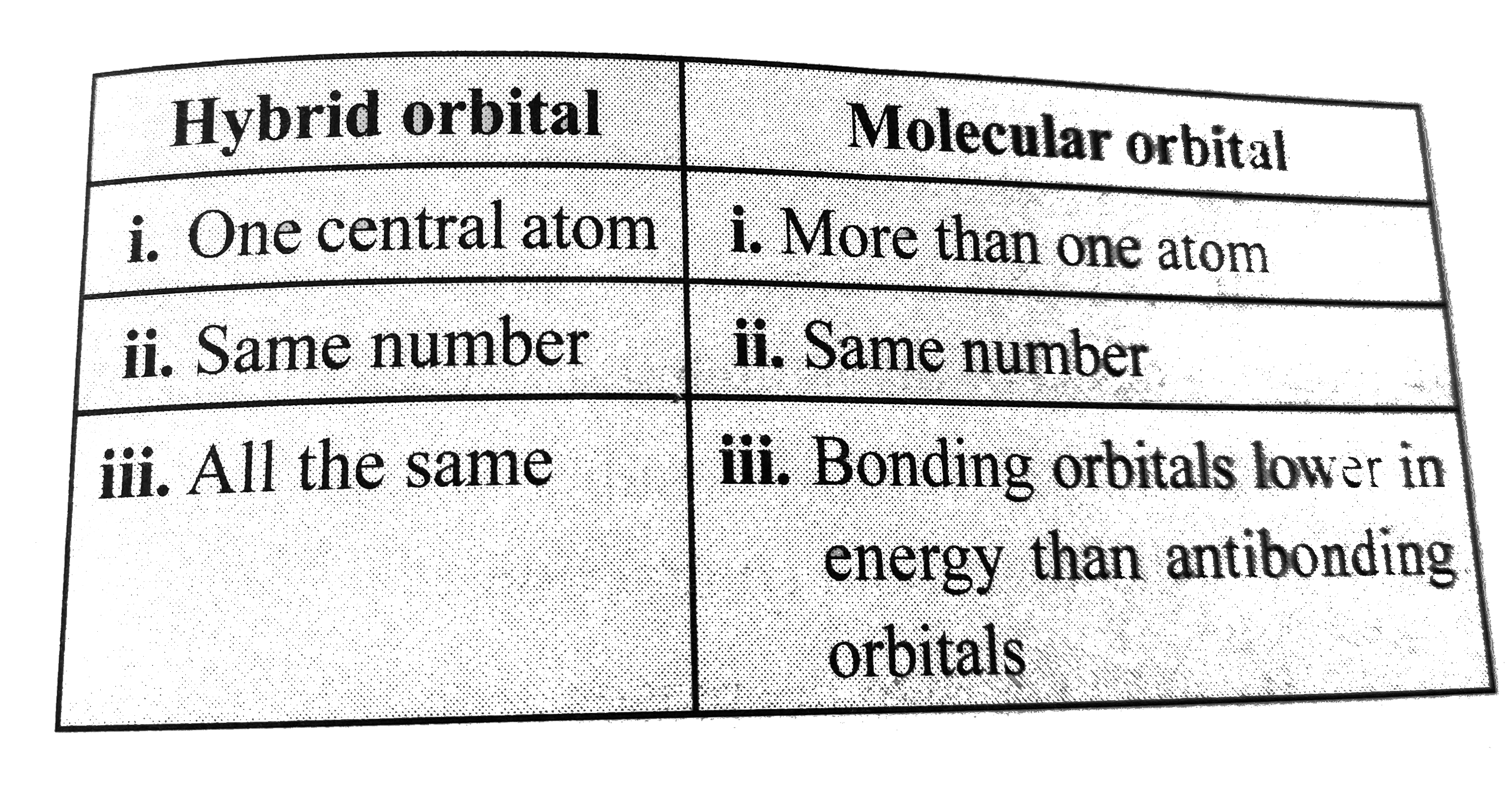Distinguish two aspects of bonding and antibonding orbitals .
To distinguish between bonding and antibonding orbitals, we can highlight two key aspects for each type of orbital.
1. Formation:
- Bonding Orbitals: These are formed by the addition (constructive interference) of atomic orbitals. When two atomic orbitals combine in phase, they create a bonding orbital that stabilizes the molecule.
- Antibonding Orbitals: These are formed by the subtraction (destructive interference) of atomic orbitals. When two atomic orbitals combine out of phase, they create an antibonding orbital that destabilizes the molecule.
2. Presence of Nodes:
- Bonding Orbitals: Bonding orbitals may or may not have a node. A node is a region where the probability of finding an electron is zero. In the case of bonding orbitals, they typically do not have a node between the nuclei of the bonded atoms.
- Antibonding Orbitals: Antibonding orbitals always have at least one node between the nuclei of the bonded atoms. This node indicates a region where the electron density is zero, which contributes to the destabilization of the molecule.
Summary:
- Bonding Orbitals: Formed by addition of atomic orbitals, may or may not have a node.
- Antibonding Orbitals: Formed by subtraction of atomic orbitals, always have a node.
- Bonding Orbitals: These are formed by the addition (constructive interference) of atomic orbitals. When two atomic orbitals combine in phase, they create a bonding orbital that stabilizes the molecule.
- Antibonding Orbitals: These are formed by the subtraction (destructive interference) of atomic orbitals. When two atomic orbitals combine out of phase, they create an antibonding orbital that destabilizes the molecule.
- Bonding Orbitals: Bonding orbitals may or may not have a node. A node is a region where the probability of finding an electron is zero. In the case of bonding orbitals, they typically do not have a node between the nuclei of the bonded atoms.
- Antibonding Orbitals: Antibonding orbitals always have at least one node between the nuclei of the bonded atoms. This node indicates a region where the electron density is zero, which contributes to the destabilization of the molecule.
- Bonding Orbitals: Formed by addition of atomic orbitals, may or may not have a node.
- Antibonding Orbitals: Formed by subtraction of atomic orbitals, always have a node.
Topper's Solved these Questions
- BOOK - PRADEEPCHAPTER - CHEMICAL BONDING AND MOLECULAR STRUCTUREEXERCISE - ADDITIONAL QUESTIONS (LONG ANSWER QUESTIONS)13videos
CHEMICAL BONDING AND MOLECULAR STRUCTURE
- BOOK - PRADEEPCHAPTER - CHEMICAL BONDING AND MOLECULAR STRUCTUREEXERCISE - ANALYTICAL QUESTIONS AND PROBLEMS WITH ANSWERS/SOLUTIONS (Questions)1videos
CHEMICAL BONDING AND MOLECULAR STRUCTURE
- BOOK - PRADEEPCHAPTER - CHEMICAL BONDING AND MOLECULAR STRUCTUREEXERCISE - ADDITIONAL QUESTIONS (VERY SHORT ANSWER QUESTIONS )57videos
CHEMICAL BONDING AND MOLECULAR STRUCTURE
- BOOK - PRADEEPCHAPTER - APPENDIXEXERCISE - MODEL TEST PAPER <br> (Section C )9videos
APPENDIX
- BOOK - PRADEEPCHAPTER - CLASSIFICATION OF ELEMENTS AND PERIODICITY IN PROPERTIES EXERCISE - Competition Focus (Jee Main and Advanced / Medical Entrance ) ( Assertion - Reason Type Question ) (Type II)12videos
CLASSIFICATION OF ELEMENTS AND PERIODICITY IN PROPERTIES
Similar Questions
Compare and contrast the concepts of hybrid orbitals and molecular orbitals with respect to
(i) The number of atoms involved
(ii) The number of orbitals produced from a given number of ground state orbitals
(iii) The energies of the resulting orbitals with respect to one another
(b) Distinguish between non-bonding and antibonding orbitals
 .View Solution
.View SolutionDistinguish between antibonding and nonbonding orbitals.
View Solution
Knowledge Check
- Question 1 - Select One
The bond order depends on the number of electrons in the bonding and antibonding orbitals. Which of the following statement is/are correct about bond order ?
Acannot be a negative quantityBhas always an integral valueCcan assume any value ,positive , negative
integral or fractional , including zeroDis a non-zere quantity - Question 2 - Select One
The bond order depends on the number of electrons in the bonding and antibonding orbitals. Which of the following statement is/are correct about bond order ?
ABond order cannot have a negative value.BIt always has an integral valueCIt is a nonzero quantityDIt can assume any value-positive or negative, integral or fractional, including zero. - Question 3 - Select One
Bond order is a concept in the molecular orbital theory. It depends on the number of electrons in the bonding and antibonding orbitals. Which of the following statements is true about ? The bond order
ACan have a negative quantityBHas always an integral valueCcan assume any positive or integral or fractional value including zeroDIs a non zero quantity
Assertion Bond order in a molecule can assume any value positive integral or fractional value including zero
Reasoning It depends on number of electrons in the bonding and antibonding orbitals .View SolutionStatement 1 : Bond order in a stable molecule can be fractional.
Statemetn 2: The value of bond order depends upon the number of electrons in bonding and antibonding molecular orbitals.View SolutionMolecular orbital theory is based on linear combination of atomic orbitals (LCAO). According to LCAO when respective atomic orbitals of the atoms interact, they undergo constructive and destructive interference giving rise to two types of molecular orbitals, that is, bonding and antibonding molecular orbitals.
If z is the molecular axis then which of the following overlapping results in non-bonding molecular orbital?View SolutionMolecular orbital theory is based on linear combination of atomic orbitals (LCAO). According to LCAO when respective atomic orbitals of the atoms interact, they undergo constructive and destructive interference giving rise to two types of molecular orbitals, that is, bonding and antibonding molecular orbitals.
Calculate the bond order and magnetic nature of the F2+2, if sp intermixing is not considered and Hund's rule is also violated.View SolutionIf E is the total energy of the combining atomic orbitals, and Eb and Ea are the energies of the bonding and antibonding molecular orbitals formed, respectively, then
View Solution

